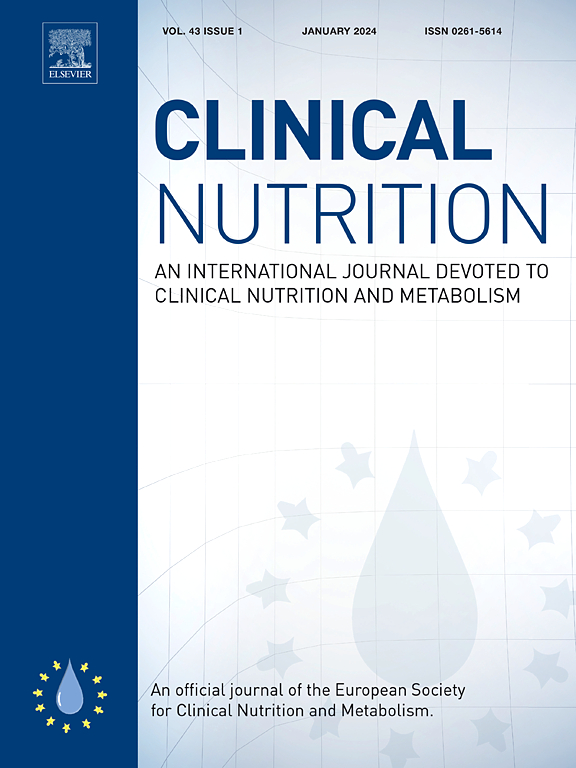Sarcopenic obesity and the risk of atrial fibrillation in non-diabetic older adults: A prospective cohort study
IF 6.6
2区 医学
Q1 NUTRITION & DIETETICS
引用次数: 0
Abstract
Background
Evidence of an association between sarcopenic obesity (SO) and the risk of long-term atrial fibrillation (AF) is lacking, and the underlying involvement of insulin resistance (IR) and inflammation is not clear.
Methods
This community-based prospective cohort study evaluated sarcopenia, obesity, and baseline clinical characteristics in 4321 non-diabetic older adults between 2007 and 2011. Sarcopenia was identified using skeletal muscle mass/body weight (SMM/BW), appendicular lean mass (ALM)/BW, and handgrip strength (HGS), and obesity was identified by fat mass (FM)/BW. The association of sarcopenia and obesity with AF risk was determined by Kaplan–Meier analysis and a Cox proportional hazards model. Interaction analysis, a restricted cubic splines model, mediation analysis, and a Fine–Gray competing-risk model were also used.
Results
Over an average of 10.9 years of follow-up, 546 (11.98 per 1000 person-years) participants developed AF. Low SMM/BW, low ALM/BW, low HGS, high FM/BW, sarcopenia and obesity, were significantly associated with an increased AF risk. There was a significant synergistic relationship between sarcopenia and obesity in the increased AF risk [hazard ratio (HR): 2.029, 95 % confidence interval (CI): 1.639–2.512]. Compared with participants without sarcopenia and obesity, AF risk was the highest in those with SO (HR: 2.669, 95 % CI: 2.110–3.377], followed by sarcopenia alone (HR: 1.980, 95%CI: 1.453–2.699) and obesity (HR: 1.839, 95%CI: 1.475–2.292). Mediation analysis found that estimated glucose disposal rate (a surrogate marker of IR), high-sensitivity C-reactive protein, and galectin-3 were mediating factors in the increased AF risk caused by SO, accounting for 34.87 %, 27.56 %, and 21.05 % of the total effect, respectively.
Conclusions
SO significantly increased AF risk in these non-diabetic older individuals. Sarcopenia and obesity not only acted alone but also exhibit had a synergistic relationship to increase AF risk. IR and inflammation mediated the increased AF risk associated with SO.
非糖尿病老年人肌少性肥胖和房颤风险:一项前瞻性队列研究
背景肌少性肥胖(SO)与长期房颤(AF)风险之间的关联缺乏证据,并且胰岛素抵抗(IR)和炎症的潜在参与尚不清楚。方法:这项基于社区的前瞻性队列研究评估了4321名2007年至2011年非糖尿病老年人的肌肉减少症、肥胖和基线临床特征。通过骨骼肌质量/体重(SMM/BW)、阑尾瘦肉质量(ALM)/体重(BW)和握力(HGS)识别肌肉减少症,通过脂肪质量(FM)/体重(BW)识别肥胖。通过Kaplan-Meier分析和Cox比例风险模型确定肌肉减少症和肥胖与房颤风险的关系。交互分析、限制三次样条模型、中介分析和细灰色竞争风险模型也被使用。结果在平均10.9年的随访中,546名参与者(11.98 / 1000人年)发生房颤。低SMM/BW、低ALM/BW、低HGS、高FM/BW、肌肉减少症和肥胖与房颤风险增加显著相关。肌少症和肥胖在增加AF风险方面存在显著的协同关系[危险比(HR): 2.029, 95%可信区间(CI): 1.639-2.512]。与没有肌肉减少症和肥胖的参与者相比,急性心肌梗死的风险最高(HR: 2.669, 95%CI: 2.110-3.377),其次是肌肉减少症(HR: 1.980, 95%CI: 1.453-2.699)和肥胖(HR: 1.839, 95%CI: 1.475-2.292)。中介分析发现,估计葡萄糖处置率(IR的替代标志物)、高敏c反应蛋白和半乳糖凝集素-3是SO导致AF风险增加的中介因素,分别占总效应的34.87%、27.56%和21.05%。结论:so显著增加非糖尿病老年人房颤风险。肌少症和肥胖不仅单独作用,而且表现出增加AF风险的协同关系。IR和炎症介导与SO相关的AF风险增加。
本文章由计算机程序翻译,如有差异,请以英文原文为准。
求助全文
约1分钟内获得全文
求助全文
来源期刊

Clinical nutrition
医学-营养学
CiteScore
14.10
自引率
6.30%
发文量
356
审稿时长
28 days
期刊介绍:
Clinical Nutrition, the official journal of ESPEN, The European Society for Clinical Nutrition and Metabolism, is an international journal providing essential scientific information on nutritional and metabolic care and the relationship between nutrition and disease both in the setting of basic science and clinical practice. Published bi-monthly, each issue combines original articles and reviews providing an invaluable reference for any specialist concerned with these fields.
 求助内容:
求助内容: 应助结果提醒方式:
应助结果提醒方式:


